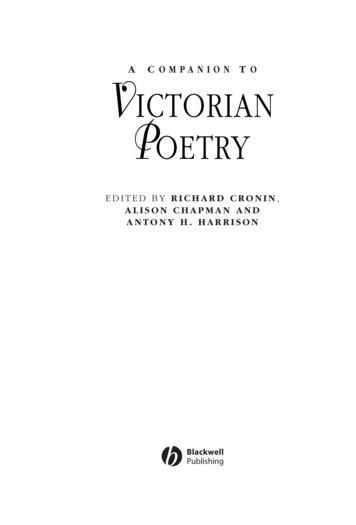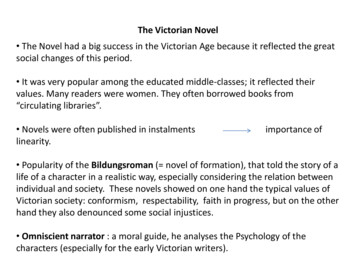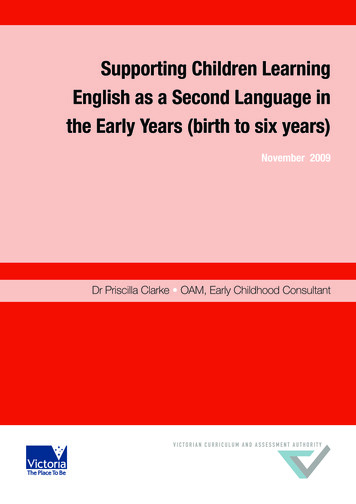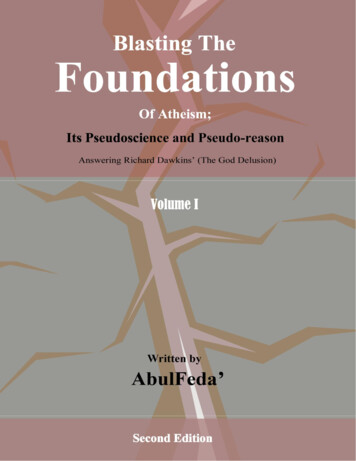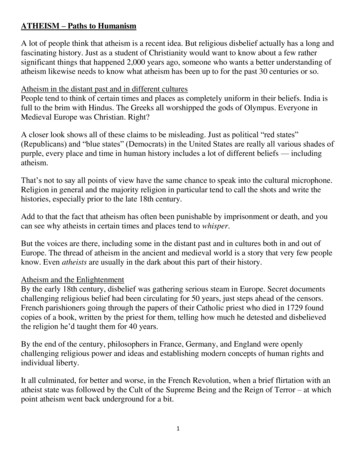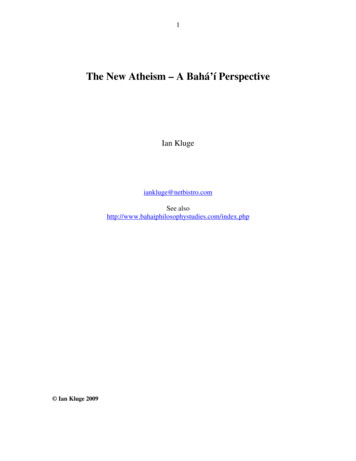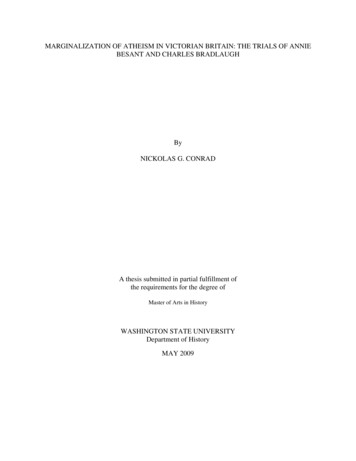
Transcription
MARGINALIZATION OF ATHEISM IN VICTORIAN BRITAIN: THE TRIALS OF ANNIEBESANT AND CHARLES BRADLAUGHByNICKOLAS G. CONRADA thesis submitted in partial fulfillment ofthe requirements for the degree ofMaster of Arts in HistoryWASHINGTON STATE UNIVERSITYDepartment of HistoryMAY 2009
To the Faculty of Washington State University:The members of the Committee appointed to examine the thesis of NICKOLASG. CONRAD find it satisfactory and recommend that it be accepted.Steven Kale, Ph.D., ChairHeather Streets, Ph.D.Raymond Sun, Ph.D.ii
ACKNOWLEDGMENTIt is my pleasure to thank the people who helped make this work possible.I would like to thank Professor Steven Kale for his patience and guidance through mytime as a graduate student at Washington State University. His helpful suggestions and adviceover two years aided me in carefully defining and understanding my own interests. As my thesischair, his help and critical analysis steered me in the right directions when I was heading offcourse. Further, his ability to see things where I could not taught me to see deeper into mysubject area.I would also like to thank Professor Heather Streets for her time and energy in reviewingmy drafts. Her critical eye found many points in content and grammar that I had passed over,and because of her input, the work is much stronger.Thanks to Professor Raymond Sun as well, who cheerfully participated throughout theprocess. His wonderful attitude, insightful questions, and responses were invaluable and broughtto my attention further areas of exploration.Finally, any weaknesses and mistakes still inherent in the project are my own. Within thetime frame allotted, I could only strive to the standards my committee pushed me towards.iii
MARGINALIZATION OF ATHIESTS IN VICTORIAN BRITAIN: THE TRIALS OF ANNIEBESANT AND CHARLES BRADLAUGHFOR WSU STUDENTSAbstractby Nickolas G. ConradWashington State UniversityMay 2009Chair: Steven KaleAtheists and freethinkers in nineteenth century Victorian Britain were imprisoned andoppressed. This thesis will seek to illuminate how and why atheists were marginalized in societyby examining the persecution of atheists and the collective values in Victorian culture. Thepremise is that the values of Victorian society were inseparable from religious belief and that theVictorian political, social, and intellectual culture created a normative structure that pusheddisbelievers to the margins. Victorian religious culture was maintained by several factors. First,it was maintained by the use of the blasphemy laws that were often used against the leaders ofthe Freethought movement. Second, religion permeated private life and personal morality,causing atheism to seem immoral. Third, education incorporated religion as part of its teachings,normalizing its predominance. Through these factors atheism was marginalized by law, claimsof immorality, and lack of public space. Atheists resisted these factors by appealing to freedomof speech, religious toleration, legal rights, and moral persuasion.The Victorian collective religious culture will be more closely examined in the trial theQueen v. Charles Bradlaugh and Annie Besant. In this trial the prosecution argues thatBradlaugh and Besant were corrupting the masses by publishing Fruits of Philosophy, apamphlet advocating contraception and population controls. By providing rational argument foriv
the need of poor people to limit their family size, atheists challenged conventional morality andreligious notions of the body, further secularizing the body and private life.Charles Bradlaugh’s election as a Member of Parliament was blocked because he soughtan alternative to the religious oriented Parliamentary oath when first swearing in to the House.His case represents the different side to the same coin. As an elite, his critics thought he wouldpoison society by his degenerate beliefs and delegitimize the religious identity of Parliament, thehighest institution in Britain. Bradlaugh’s successful entrance was a victory for religioustoleration and a further advancement of secularism.The goal of making these arguments is to shed light on the marginalization of atheism asa wide-ranging cultural phenomenon in Britain.v
TABLE OF CONTENTSPageACKNOWLEDGEMENTS .iiiABSTRACT. ivCHAPTERINTRODUCTION .11. MORALITY AND MARGINALIZATION: THE STATE, PRIVATE LIFE,AND EDCUATION. 112. UNHOLY DESIRES: THE TRIAL OF ANNIE BESANT AND CHARLESBRADLAUGH . 533. THE WOLF IS AT THE GATE: THE RELIGIOUS ELEMENT OFBRADLAUGH’S EXCLUSION FROM PARLIAMENT .95CONCLUSION 127BIBLIOGRAPHY .142vi
INTRODUCTIONIn the nineteenth century, Britain achieved a higher level of religious toleration then in allprevious centuries and had also extended the right to vote to the majority of men. It was acentury notable for its achievements in religious and political liberty. Britain had started theprocess of religious toleration two centuries prior in 1689 with the creation of the Toleration Act.Parliament later expanded the Toleration Act to include Unitarians in 1813, Roman Catholics in1832, and Jews in 1858. Yet nearly thirty years after Jews were admitted into Parliament,disbelievers were barred from Parliament and speaking against religion was still a crime. Withinits laws Britain had established laws to respect religious belief and personal conscience, butdisbelief still ran against religious traditions that exposed a lack of toleration. Laws againstblasphemy, oaths of allegiance to God in Parliament and in the court houses clearlydemonstrated to nonbelievers that Britain did not have true religious liberty. The ideals of libertyand freedom, however, already contained within them the justification for the inclusion ofdisbelief. Freethinkers knew this and so they fought for it.The historian Owen Chadwick argues that once citizens of liberal governments had tastedfreedom, it led to a slippery slope of inquiry, religious doubt, and questioning. Disbelief waspart of a new element in society that was struggling free from the domination of rich land lordsand old traditions. The problem was that overturning old customs caused new vulnerabilities.New “natural” rights were sought that were wider and more universal to protect weaker elementsfrom the stronger. Chadwick argues that once true religious freedom was conceived, society hadto change to accommodate it:If the right to be irreligious is won, then the institutions, privileges, customs, of a stateand society must be dismantled, sufficiently dismantled at least, to prevent the state or1
society exercising pressure upon the individual to be religious if he wishes not to bereligious. The liberal state, carried out logically, must be the secular state. 1This thesis seeks to explain why British society tolerated different religious beliefs butnot the lack of belief, i.e. atheism, while simultaneously exposing atheisms culturalmarginalization. The purpose will be to explain why and in what ways atheism was seen as athreat and incompatible with nineteenth-century British culture. It will be argued that religiousbelief was entangled with everyday life, causing atheism to be marginalized by religioustraditions that depended on the denial of atheism to justify itself. The argument of Chapter One isthat Church and State were inseparable and that religious ideology permeated society and privatelife, causing the British government to defend Christian values. Further, two cases will beexamined in order to provide a deeper analysis of the language used to justify the persecution ofatheism. The second chapter is focused on Annie Besant and Charles Bradlaugh’s trial in 1877over the issue of publishing a pamphlet that promoted contraception and was labeled obscene.The language used to persecute Besant and Bradlaugh accused them of being a menace to societywho threatened the morality among the masses by spreading their immoral beliefs. The thirdchapter focuses on the religious language used to exclude Bradlaugh as the first declared atheistelected to Parliament in 1880. Parliament was the symbolic embodiment of the cultural values ofBritish culture, elected to legislate and protect British society. The central issue for thedefenders of religious morality was that atheism would cause the disintegration of society byremoving the moral cement that held it together.The cases taken together represent the different sides to the same coin. The contraceptiontrial demonstrated to Christians that atheists supported immorality and threatened to pollute themasses by cheaply disseminating their ideas. Similarly, Charles Bradlaugh’s entrance intoParliament represented an intrusion into the culture of the elites, who ruled by decree and moral1Owen Chadwick, The Secularization of the European Mind in the 19th Century (Cambridge: Cambridge UniversityPress, 1975), 272
example. Bradlaugh’s status as a Member of Parliament undermined elite authority and thereligious justification for obedience to law and government. Bradlaugh’s presence would poisonsociety by turning him into a moral example for British society.Previous works that focus on secularization or Freethought have not exclusivelyattempted to tease out the arguments for the persecution of disbelief in British society. EdwardRoyle is perhaps the most notable British historian of nineteenth-century Freethought. His twoworks, written in the 1970s, cover the nineteenth century. Victorian Infidels: The Origins of theBritish Secularist Movement 1791-1866 gives an introduction to the movement itself andexplains the historical actors. His other work, Radicals, Secularists and Republicans: PopularFreethought in Britain, 1866-1915 continues this narrative, detailing the obstacles andconstituent parts of the main groups and actors during the second half of the century. The twoworks serve as the best examination to British secularism in the nineteenth century. Anothergreat overview of the secular movement in the period is A History of the British SecularMovement by John McGee. Other works such as The London Heretics by Warren SylvesterSmith and English Radicalism 1853-1886 give atheism a chapter or two that outlines the majorevents and players without fully explaining the reasons for its cultural marginalization. In AHistory of Atheism in Britain: From Hobbes and Russell, David Berman provides an intellectualaccount of the persecution of atheism by focusing on the reasons that atheism was believed to notexist. Berman argues that believers created a culture that considered disbelief impossible inorder to assure themselves that religious belief was universal and innate, which also reinforcedreligious culture by marginalizing any who disbelieved. Nicolas Walter’s work Blasphemy:Ancient & Modern (1990) is an excellent work that provides a focused survey of the persecutionsof atheists through the blasphemy laws, which this thesis is greatly indebted. There are severallarger works that cover nineteenth-century Freethought, most notably J.M. Robertson’s Historyof Freethought in the Nineteenth Century (1929), J. McCabe’s A Rationalist Encyclopedia3
(1948), and David Tribe’s 100 Years of Freethought (1967). This thesis will add to this literatureby providing a closer look at the cultural arguments and cultural mores to expose the particularreasons atheists were so feared. It also has larger historical importance in that it seeks to uncoverone of the ways by which society tries to create conformity and obedience to a single culture. Inthis sense this thesis speaks to the reasons and justifications a dominant culture gives formarginalizing undesirables, be it at one time Catholics, Jews, atheists, or homosexuals.The works that have been written on the two test cases, the trial of Charles Bradlaugh andAnnie Besant for obscenity and Bradlaugh’s Parliamentary struggles, have mostly been politicaland chronological accounts. Roger Manvell’s work on The Trial of Annie Besant (1976) gives achronological account of events with an abridged publication of the trial transcripts and is also atribute to the love story of Besant and Bradlaugh. Bryan M. Yates’ Master’s Thesis, entitled AProsecution Fraught with Danger: The Trial of Charles Bradlaugh and Annie Besant (1966),examined the ideology of class and gender surrounding the case. Charles Knowlton was an earlynineteenth-century American doctor who published a pamphlet on contraception. Yates arguesthat Charles Knowlton’s ideas, propagated through Annie Besant and Charles Bradlaugh,threatened established morality and gender roles. While not disagreeing with Yates’ analysis ofthe importance of sex and gender, this thesis argues that the most important cultural factorsupporting gender roles and conventional morality was religious ideology. Besant andBradlaugh’s willingness to publish this pamphlet demonstrated to theists that atheists wereimmoral and socially destructive.There are a handful of works written on Charles Bradlaugh’s Parliamentary experiences.Walter Arnstein provides an excellent account in his 1965 work, The Bradlaugh Case: A Study inLate Victorian Opinion and Politics, to which this thesis cannot compare. However, ChapterThree on Bradlaugh’s parliamentary struggles seeks to situate his story into the context of thecultural phenomena of the marginalization of atheism. The analysis provided in Chapter Three4
has really less to do with Bradlaugh then the effort to tease out the cultural threat that Bradlaughrepresented. Joseph Anthony Ilardo’s dissertation, “The Bradlaugh Case: A Study of theParliamentary Debates Concerning the Affirmation Oath Controversy, 1880-1891” (1969) is alsoan excellent and thorough analysis of the debates within Parliament surrounding Bradlaugh.Gordon Robertson, Jr.’s Master’s Thesis, “Charles Bradlaugh and the Affirmation Controversy”(1962) is a chronological and political account. Ruth Pearce Carmichael’s Master Thesis, “TheParliamentary Oath Controversy” (1932) was one of the first attempts to explore the events.None of these works, other than Arnstein’s to some degree, attempt to explain the deeper culturalundercurrents that were vying for dominance.This work is a study of the culture surrounding the persecution of atheists. Thenineteenth century witnessed the rise of both belief and disbelief and was a time of culturalturmoil and changing mores. While this is seemingly contradictory, since where one rises theother would must fall, the era witnessed a general heightened discourse of religious belief. In thework The Making of Victorian England Kitson Clark argues that religion “pervaded all society,challenged men and women of every level of society or of education and became fused with theobjectives of most political parties and the hopes of every class.” 2 Clark says the year 1859 wasfollowed by a religious surge, suggesting that the dominant culture was still one of Christianbelief with punctuated exceptions of disbelievers. It was still dangerous to attack religion unlessthe critic was speaking before a highly educated audience. Churchgoing was still high, causingforeigners sometimes to make comment on it. Public discussion still centered on religioussubjects and had a tone that was highly pietistic. 3British people were consciously aware of a stark break with the past. The traditionalfoundations of the Middle Ages were coming undone and the Victorians were the first generation23Kitson Clark, The Making of Victorian England,(Cambridge Massachusetts 1962), 147Clark, The Making of Victorian England, 1475
to face the dilemmas of modern life. The old assumptions about one’s station in life wereoverturned, casting people adrift in an age that deeply questioned the traditional beliefs ofmorality and religion. John Stuart Mill called it a time of “intellectual anarchy.” EnglishMedieval society had been ruled by Christian orthodoxy through the domination of the church,which in turn was ruled by nobility and king. Society had consisted of fixed classes in rigidhierarchies with an economic system based in village agriculture and town guilds. All of thiswas challenged when the French Revolution of 1789 rejected class inequality, asserted thedemocratic Rights of Man, and admonished the worship of the Goddess of Reason. 4 Freethoughtchallenged society and represented a larger trend occurring in Britain. All of society wasconfronted with new questions about God, religious restrictions, equality and the limits ofliberty. According to Houghton in The Victorian Frame of Mind, the years between 1830-1870were a time of acute crisis for Victorian intellectuals. This crisis was felt at the same time thatthe authority of the Church and aristocracy declined. It led many thinkers to deeply focus theirattention on the contemporary scene more than they had ever done before. This causedcompetition between different ideologies over political, religious, and moral issues. 5Britain was not truly religiously tolerant—it was tolerant to Protestants, Catholics, andeventually Jews because they did not denounce the Christian Anglican god. Religious opinionwas not free and atheism was suppressed by a dominant culture of religious belief. In order toclearly see this, it is important to recognize how perceptions of religious morality were used tooppress atheism and religious liberty. This religious mentality was maintained through theestablishment that consisted of state law, culture, and education. The dominant culture wasdefined and dependant on religious belief, and by nature of its composition, pushed atheism andits adherents into a position of marginalization.45Hougton, The Victorian Frame of Mind 1830-1870 (New Haven: Yale University Press 1957), 2Hougton, The Victorian Frame of Mind 1830-1870, xvi6
Atheists and disbelief were marginalized in nineteenth-century Britain because theysought to redefine the limits of freedom and liberty and overturn the overwhelming weight oftradition. If nonbelievers were to be permitted within the limits of religious freedom, there had tobe freedom to criticize all forms of religious belief. Acceptance of diverse religious opinion wasthe result of divided religious loyalties, in Britain non-Anglican Protestants made nearly half ofthe religious population. The logical process of tolerating dissenting religious opinion istoleration of opinion, regardless of view.Christian Britain was being dismantled from the fringes by nonbelievers who soughtinclusion into society. Yet most Christians considered society to be based on Christian morals,which meant that Radical atheists were not only challenging religious authority but religion’sself-proclaimed monopoly over the foundations of public morality. Nonbelievers sought toredefine morality and extend the limits of liberty.George Watson in his work English Ideology defines ideology as a systematic form ofthinking that has its foundations in morality. Ideology defines the conviction of people by layingout what is right or wrong based on assumed premises and beliefs. The English had created theirown particular form, founded in their parliamentary political tradition that rejected unlimitedcentral authority. Watson says, “The English ideology is about the liberty of man.” 6 Yet libertywas an ideal, not a reality. All human communities sacrifice their unfettered freedom to coexistwithin society. No human animal, man or women, is free from the compulsion to survive, andunless they live alone, each man or women must work out a method of cooperation. Liberty is apolitical concept by which people envision the parameters of human interaction. To discussliberty is really a discussion about what the permissible limits are of human obligation, duty, and6George Watson. The English Ideology: Studies in the language of Victorian Politics (London: Ebenezer Baylis andSon, Limited, 1973), 197
restraint. The crux of the issue is how to determine what is right and what is wrong, which isbased on perceptions of reality.The conceptual framework of this thesis is grounded in the practical notion of liberty innineteenth-century Britain. The boundaries of liberty sets the limits of what is allowed, but justbecause people are free to act in certain fashions, does not mean that society considers thepermitted act to be moral. A society that posits liberty as its creed must depend on the individualactions and choices of its citizens, putting critical reliance on their moral and ethical behavior.People are free to drink alcohol with the assumption that most people will not drink themselvesto an early death. Liberty is not an ideology of obedience because it is a philosophy of limits andnot commands; however, it requires conformity to perceived universal codes and moral values.Society has to create an ethical citizen body for society to properly function; if it could notestablish such norms, society would degrade into anarchy. Thus civic and private morality arecrucial issues to any society that allows the inclusion of the whole citizen body in thedeliberation process. It requires conformity not only of the elites, but also of the lowesteconomically contributing member. To inculcate the correct values in society both the publicand private spheres of life are intertwined with personal morality. Victorian moral ideology,deeply intertwined with religion, was bent on creating citizens through moral education whoparticipated in good domestic hygiene, restraint, and self-help. 7Religion is an unquestionable bedrock for ethical decrees and has historically been usedto enforce behavioral conformity. Religions demand behavior to be in accordance to a divineplan, creating an enormous incentive and promoting obedience. When people privately act inaccordance with a religious world view, they conceive of themselves acting in tune with the lawsof the universe. Religion also helps maintains traditions, since religious doctrine is theoreticallynot supposed to change. Once conformity or conversion is accepted, religion provides a place7Watson, The English Ideology: Studies in the language of Victorian Politics, 48
that invites inclusion, perpetuation, and unites diverse people. Consequently, religion is acultural glue that justifies conformity to moral rules both philosophically and pragmatically.Liberty on the other hand works to include people regardless of difference. Thenineteenth century was filled with debate of who should count as a citizen. Liberalismeventually led to the notion of universal citizenship in the twentieth century, but before attainingequality, Britain dealt with the issues of who was fit to participate in public life and who was not.Intellectual liberty also became a critical issue in nineteenth-century Britain, implied in the name“freethinkers” that many disbelievers took for themselves.Disbelievers changed the underlying assumptions of morality by removing God from theequation. Where some people saw a world filled with divine justice and evil malice, disbelieverssaw a cold reality made warm only through human action and will. Atheists argued that the basisof morality was not based on the Bible but on experience and reason. Atheists were especiallypersecuted because they were tampering with longstanding traditions, creating the fear thatrestraints would be abolished to a point that no police force could control. Many people foundit difficult to believe the secular reasons for obeying laws and generally being a good neighbor,especially because during the French Revolution religion was abolished and innocent peoplewere summarily executed. Once the sacred cornerstone of morality was removed, the only thingleft was reason and philosophical debate, which could theoretically go any direction. Toconcerned religious individuals, there was ample reason to stop atheism. This was why Britishsociety sought to stop atheists through legal action, seizure of publications, social ostracism, andexclusion. These were also the ways that atheists promoted the secularization of society,challenging step by step conventional morality and traditional values by accusing them of beingrestrictive, oppressive, or short sighted.Seeing the world through the terms of the western monotheistic religion of Christianity,which by internal doctrine sought conformity, caused society to persecute social deviants. The9
collective moral conception of life through a Christian ideological view had fully integrated itselfwith the state and cultural infrastructure of society. Atheists, armed with ideas of equality,liberty, and intellectual freedom, had to martyr themselves to expose the contradictions of aliberal society that had not yet acquired true religious freedom.10
CHAPTER 1MORALITY AND MARGINALIZATION: THE STATE, PRIVATE LIFE, ANDEDCUATIONThe despotism of custom is everywhere the standing hindrance to human advancement,being in unceasing antagonism to that disposition to aim at something better thancustomary, which is called, according to circumstances, the spirit of liberty, or that ofprogress or improvement. –John Stuart Mill, On Liberty, 1859The bogeyman of the Victorian era was the atheist artisan: often self-educated, unchurched, andpolitically radical, he or she disturbed the faithful and put doubt forcefully into the open. Thenonbeliever represented a counterculture position to an age dominated by religion. Britain in theVictorian era was unmistakably a Christian country. Its laws and institutions were supported bynumerous churches and sects that declared and defended the Christian religion, which in turnwas maintained by the courts and public opinion. 1 The state made atheism criminal by law whileat the same time educating its citizens in religious belief. Those who stood against religioustradition often defined themselves as freethinkers or atheists (and later in the century as agnosticsand secularists). Freethinkers and atheists either rejected the Christian religion or belief in Godaltogether. Atheists were marginalized informally through a collective culture that foundatheism repulsive. The argument of this paper is that religious ideas of morality, supported bytradition and religious institutions, compelled Victorian society to marginalize atheists eitherdirectly by persecuting them in court and suppressing their literature, or indirectly by notgranting them public space to co-exist.1Edward Royle, Victorian Infidels (Manchester 1974), 1.11
This chapter will argue that atheism was marginalized by three main pillars of custom:first, the power of a Christian state that made public atheism criminal; second, the norms of aChristian culture that permeated the daily lives of the populace and saw atheism as an immoralblight; and third, an education system that made religion part of its curriculum. The combinationof these three forces allowed almost no public space for atheism. Thus, in later chapters it willbe shown that when atheists such as Annie Besant and Charles Bradlaugh tried to create spacefor their views in society, they were suppressed or ignored through established norms. Victorianculture was saturated in religious ideology that permeated societal norms and justified punishingthose who violated the norm. Atheists fought against this formation of state power and culturalnorms, resulting in their martyrdom and persecution.At the center of discourse on the marginalization of disbelief was the debate on moralityand social conformity. Religious people feared that atheists would destroy religious faith, ruinthe foundation of morality, and cause society to dissolve into anarchy. 2 This fear justified thesuppression of atheism. The political ideology of religious toleration in Britain had made roomfor both Catholics and Jews. Disbelief, however, ran against the grain of a society defined byreligion. This is because morality was closely associated with religion. In his autobiography,John Stuart Mill described the sense that religious belief and morality were inseparable,prompting many people to believe it was essential for maintaining moral behavior. Millmentions a specific book, entitled Analysis of the Influence of Religion on the TemporalHappiness of Mankind, that he read as a child. Mill said2Walter E. Hougton, The Victorian Frame of Mind, 1830-1870 (New Haven: Yale University Press, 1957), 58.12
apart from any peculiarities of any special revelation; which, of all the parts of thediscussion concerning religion, is of the most important in this age, in which real belief inany religious doctrine is feeble and precarious, but the opinion of its necessity for moraland social purposes almost universal 3This concern for morality was turned upon the non-religious working classes especially,who were suffering through the growing pangs of the Industrial Revolution that had caused manyto break away from traditional culture. Many in the working classes also suffered the most fromstate neglect, never received an education, and lived through intolerable conditions. Religiousthinkers often saw the free and cultivated living of the working classes and their lack of religionas directly related. Indeed, the working classes were more atheistic than any other class. Thelargest cause of disbelief was often criticism of the conservative stance of the clergy, thetheological problem of evil, and the amount of suffering witnessed firsthand. Radical literaturewas critical and skeptical, and leaders like Thomas Paine and Percy Bysshe Shelley harshlycriticized Christianity. Conservatives often th
Atheists and freethinkers in nineteenth century Victorian Britain were imprisoned and . Second, religion permeated private life and personal morality, causing atheism to seem immoral. Third, education incorporated religion as part of its teachings, normalizing its predominance. Through these factors atheism was marginalized by law, claims

